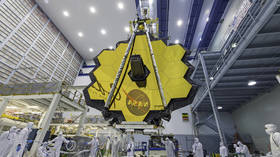NASA unveils first photo from new telescope

NASA has revealed the first photo captured with the new James Webb Space Telescope, sharing a spectacular infrared image of distant galaxies and some of the faintest objects ever observed.
The US space agency published the image on Monday alongside its European and Canadian counterparts, saying it shows “thousands of galaxies” in the far-away SMACS 0723 cluster as they appeared 4.6 billion years ago.
“This first image from NASA’s James Webb Space Telescope is the deepest and sharpest infrared image of the distant universe to date,” NASA said, adding that the photo is “overflowing with detail” and includes the “faintest objects ever observed in the infrared.”
It's here–the deepest, sharpest infrared view of the universe to date: Webb's First Deep Field.Previewed by @POTUS on July 11, it shows galaxies once invisible to us. The full set of @NASAWebb's first full-color images & data will be revealed July 12: https://t.co/63zxpNDi4Ipic.twitter.com/zAr7YoFZ8C
— NASA (@NASA) July 11, 2022
Underscoring the vast distances involved, the agency noted that the photo covers “a patch of sky approximately the size of a grain of sand held at arm’s length by someone on the ground.”
The SMACS 0723 cluster is about 4.6 billion light-years away from Earth, but the telescope can use the galaxies’ immense mass as a “gravitational lens,” allowing it to see much more distant objects in the background.
Launched last December, the James Webb Space Telescope was jointly developed with the European and Canadian space agencies, and is set to replace the aging Hubble Space Telescope, which was sent into low-Earth orbit in 1990. Webb uses a 21-foot mirror to observe objects, dwarfing Hubble’s 7.9-foot mirror and prompting NASA to dub it “the world’s largest and most powerful space telescope.” Unlike its predecessor, however, the new device maintains a solar orbit about 1 million miles from Earth, helping it to peer further into the cosmos.
The image published on Monday is the first in a series, with the rest set to be released by NASA later this week.












